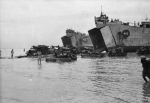NavSource Online: Amphibious Photo Archive
HM LST-403

LST-403 was transferred to the United Kingdom for the duration of World War II
Please report any broken links or trouble you might come across to the Webmaster. Please take a moment to let us know so that we can correct any problems and make your visit as enjoyable and as informative as possible.

| Click On Image For Full Size Image |
Size | Image Description | Source | |
|---|---|---|---|---|
 |
79k | HM LST-403 getting underway from the United Kingdom for Far East duty, date unknown. Note that she has been fitted with a flying bridge to assist with visibility over LCT-2120, date and location unknown. | Robert Hurst | |
 |
84k | HM LST-403 and HM LST-427 beached and discharging CEVs in the Far East. Imperial War Museum Ministry of Defense Foxhill Collection of Ship Photographs, Photo No. © IWM(FL 7160) |
Mike Green | |
| Back To The Navsource Photo Archives Main Page | Back To The Amphibious Ship Type Index | Back To The Tank Landing Ship (LST) Photo Index |
| Comments, Suggestions, E-mail Webmaster. |
|
This page is created by David W. Almond and maintained by Gary P. Priolo |